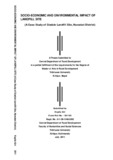Please use this identifier to cite or link to this item:
https://elibrary.tucl.edu.np/handle/123456789/2338| Title: | Socio-economic and Environmental Impact of Landfill Site: A Case Study of Sisdole Landfill Site, Nuwakot District |
| Authors: | Giri, Kopila |
| Keywords: | Environment;Waste Management;Nuwakot |
| Issue Date: | Jul-2011 |
| Publisher: | Central Department of Rural Development Tribhuvan University, Kathmandu |
| Abstract: | The present study site “Sisdole Landfill Site” is situated in Okharpauwa VDC, one of the sixty-one of the Nuwakot District of Bagmati zone. Among the various villages of the VDC sisdole is located in ward 4. The study tries to show the socio-economic and environmental impact of the Sisdole landfill site in the local community of the sisdole. In order to retrieve a broad picture of the current waste management situation, the landfill site is investigated. JICA report 2005 reveals that 70% waste is organic waste and remaining are the inorganic which can be recycled with some extent. The population growth rate of Kathmandu is more than 6% which is highest among the cities of Nepal. Due to the rapid increase in population and increase in the consumption of packed goods, the amount as well as the quantum of non- biodegradable waste is increasing over time. Among the total waste generated in Nepal, 80% is generated only from Kathmandu and only 30% of the total refuse is being collected in containers and transferred to the land fill site. A study carried out by CEDA (1986) revealed that 78% of the solid waste was biodegradable and 22% non biodegradable in Kathmandu. The Sisdole Landfill site was developed in 2005. Since then about 400-500 metric tons of wastes are disposed. It is situated in 475 Ropani of the land. The management system of this site is very weak. So that it has various harmful effects on the local people. Increasing pollution in Kolpu Khola not only destroy the water species but also effects in the irrigation system. This eventually effects on the agriculture production. Respiratory infections and diarrheal diseases can be spread due to unmanaged waste management system. After the installation of the landfill site, the local people got the road, electricity, and health post near by the site. One health post is made by authority. The site has multiple effects on human beings, animals, plants, water species and various ecosystems. The main problem of the locals is water pollution, soil pollution and health problems due to this on human and animal. According to them the facility given by authority is not enough in comparison to its harms. The recurring conflict between local and authority is also taken as the improper management system of the government. If government made proper leachate system, proper soil capping system and processing of the waste the debate would not arise. The unmanaged waste system at the landfill site, no utilization of the waste, increasing amount of the waste, v increasing pollution and health problems at landfill site and ever rising conflict between government authority and the local people are the current problems related with this sector. Although there are many problems related with the site, government authority had launched many policies such as Solid Waste management and Resource Mobilization Act-1987, National Solid Waste Management Policy-1996, Local Self Governance Act-1996. These acts and policies can be taken as the positive action towards the solid waste management. |
| URI: | http://elibrary.tucl.edu.np/handle/123456789/2338 |
| Appears in Collections: | Rural Development |
Files in This Item:
| File | Description | Size | Format | |
|---|---|---|---|---|
| giri kop.pdf | 1.59 MB | Adobe PDF |  View/Open |
Items in DSpace are protected by copyright, with all rights reserved, unless otherwise indicated.
